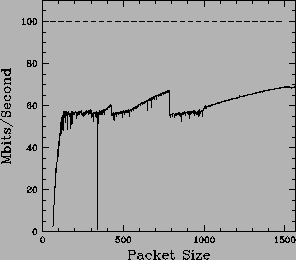Netperf is a venerable and well-written tool for measuring a variety of critical measures of network performance. Some of its features are still not duplicated in the lmbench 2 suite; in particular the ability to completely control variables such as overall message block size and packet payload size.
A naive use of netperf might be to just call
For each message sent, the time required goes directly into an IPC time
like ![]() . In the minimum 200 microseconds that are lost, the CPU
could have done tens of thousands of floating point operations! This is
why network latency is an extremely important parameter in beowulf
design.
. In the minimum 200 microseconds that are lost, the CPU
could have done tens of thousands of floating point operations! This is
why network latency is an extremely important parameter in beowulf
design.
Bandwidth is also important - sometimes one has only a single message to send between processors, but it is a large one and takes much more than the 200 microseconds latency penalty to send. As message sizes get bigger the system uses more and more of the total available bandwidth and is less affected by latency. Eventually throughput saturates at some maximum value that depends on many variables. Rather than try to understand them all, it is is easier (and more accurate) to determine (maximum) bandwidth as a function of message size by direct measurement.
Both netperf and bw_tcp in lmbench allow one to directly select the message size (in bytes) to make a measurements of streaming TCP throughput. With a simple perl script one can generate a fine-grained plot of overall performance as a function of packet size. This has been done for a 100BT connection between lucifer and ``eve'' (a reasonably similar host on the same switch) as a function of packet size. These results are shown in figure 9.1.
 |
Figure 9.1 reveals a number of surprising and even disappointing features. Bandwidth starts out small at a message size of one byte (and a packet size of 64 bytes, including the header) and rapidly grows roughly linearly at first as one expects in the latency-dominated regime where the number of packets per second is constant but the size of the packets is increasing. However, the bandwidth appears to discontinuously saturate at around 55 Mbps for packet sizes around 130 bytes long or longer. There is also considerable (unexpected) structure even in the saturation regime with sharp packet size thresholds. The same sort of behavior (with somewhat different structure and a bit better asymptotic large packet performance) appears when bw_tcp is used to perform the same measurement. We see that the single lmbench result of a somewhat low but relatively normal 11.2 MBps (90 Mbps) for large packets in table 8 hides a wealth of detail and potential IPC problems, although this single measure is all that would typically be published to someone seeking to build a beowulf using a given card and switch combination.